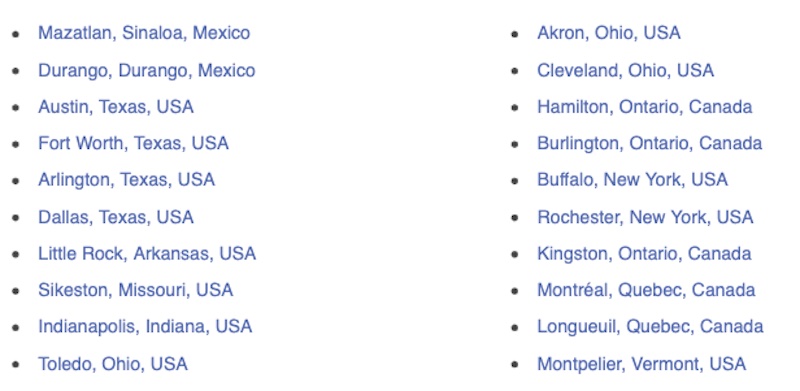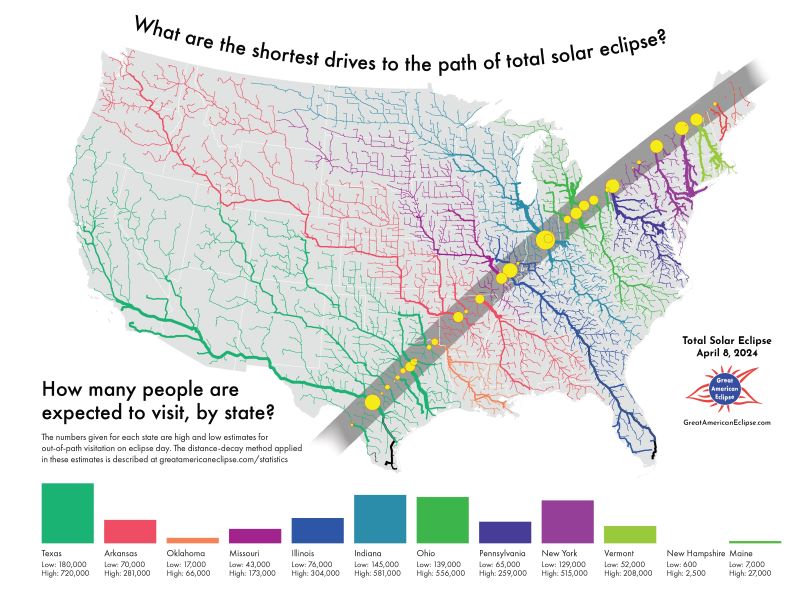Cities where the total solar eclipse was visible
 Cities where the partial solar eclipse of April 8, 2024, is visible, via timeanddate.com.
Cities where the partial solar eclipse of April 8, 2024, is visible, via timeanddate.com.When the eclipse happened worldwide
Partial eclipse begins: at 15:42 UTC on April 8.
Total eclipse begins: at 16:38 UTC on April 8.
Greatest eclipse: at 18:17 UTC on April 8.
Total eclipse ends: at 19:55 UTC on April 8.
Partial eclipse ends: at 20:52 UTC on April 8.
Note: The instant of greatest eclipse – when the axis of the moon’s shadow cone passes closest to Earth’s center – takes place at 18:17 UTC. It’s a relatively long total eclipse with a duration of totality lasting 4.47 minutes.
 Only the total stage of the eclipse is safe to view without a filter. Image via AAS.
Only the total stage of the eclipse is safe to view without a filter. Image via AAS.
 April 8, 2024, total solar eclipse, as seen from the moon’s vantage point. The moon’s large penumbral shadow is lightly shaded and is outlined with a solid black edge. A partial eclipse is visible from within this penumbra. A total eclipse is visible along the yellow line. Animation by Fred Espenak and Michael Zeiler.
April 8, 2024, total solar eclipse, as seen from the moon’s vantage point. The moon’s large penumbral shadow is lightly shaded and is outlined with a solid black edge. A partial eclipse is visible from within this penumbra. A total eclipse is visible along the yellow line. Animation by Fred Espenak and Michael Zeiler.
Eclipse maps from Great American Eclipse
Michael Zeiler of GreatAmericanEclipse.com has generously given us permission to share his eclipse maps for the total solar eclipse. Here you can get a better idea of where you’ll want to be and when to see this unique phenomenon.
 This map shows how much of the sun will be in eclipse by location on April 8, 2024. Image via GreatAmericanEclipse.com.
This map shows how much of the sun will be in eclipse by location on April 8, 2024. Image via GreatAmericanEclipse.com.
 Everyone in the contiguous United States will see at least a partial eclipse on April 8, 2024. But those in a swath that extends from Texas to Maine will see a total eclipse. Image via GreatAmericanEclipse.com.
Everyone in the contiguous United States will see at least a partial eclipse on April 8, 2024. But those in a swath that extends from Texas to Maine will see a total eclipse. Image via GreatAmericanEclipse.com.
 View larger. | This is the path of totality for the solar eclipse on April 8, 2024, containing the names of cities inside the path of totality. Keep in mind, however, that the cities on the edges of the path will see totality for just seconds, while those at the centerline will see totality for up to up to 4 1/2 minutes the farther south they are. The centerline at the northern end of the eclipse will see totality for just under 4 minutes. Image via GreatAmericanEclipse.com.
View larger. | This is the path of totality for the solar eclipse on April 8, 2024, containing the names of cities inside the path of totality. Keep in mind, however, that the cities on the edges of the path will see totality for just seconds, while those at the centerline will see totality for up to up to 4 1/2 minutes the farther south they are. The centerline at the northern end of the eclipse will see totality for just under 4 minutes. Image via GreatAmericanEclipse.com.
Which location was closest to you?
 View larger. | If you live in the contiguous United States, this map shows you the closest location you’d need to drive to in order to see the total solar eclipse of April 8, 2024. Image via GreatAmericanEclipse.com.
View larger. | If you live in the contiguous United States, this map shows you the closest location you’d need to drive to in order to see the total solar eclipse of April 8, 2024. Image via GreatAmericanEclipse.com.
Maps for the timing of the eclipse
 View larger. | It’s not only important to be under the path of totality for the total solar eclipse, but you want to be as close to the centerline as possible as well. That makes the difference between seeing the total solar eclipse for just seconds, versus seeing the total eclipse for more than 4 minutes, depending on your location. Image via GreatAmericanEclipse.com.
View larger. | It’s not only important to be under the path of totality for the total solar eclipse, but you want to be as close to the centerline as possible as well. That makes the difference between seeing the total solar eclipse for just seconds, versus seeing the total eclipse for more than 4 minutes, depending on your location. Image via GreatAmericanEclipse.com.
 View larger. | This map shows the time that partial phase begins for the eclipse on April 8, 2024. Image via GreatAmericanEclipse.com.
View larger. | This map shows the time that partial phase begins for the eclipse on April 8, 2024. Image via GreatAmericanEclipse.com.
 View larger. | This map shows the moment of greatest eclipse by location. For those in the path of totality, it shows the mid-point of the total eclipse, and for those outside totality, it shows the time when the sun will be most covered by the moon. Image via GreatAmericanEclipse.com.
View larger. | This map shows the moment of greatest eclipse by location. For those in the path of totality, it shows the mid-point of the total eclipse, and for those outside totality, it shows the time when the sun will be most covered by the moon. Image via GreatAmericanEclipse.com.
How long did the eclipse last?
 View larger. | The total solar eclipse only falls along a narrow path across the United States on April 8, 2024. And the farther south you are on the track of totality, the longer the duration of totality. Image via GreatAmericanEclipse.com.
View larger. | The total solar eclipse only falls along a narrow path across the United States on April 8, 2024. And the farther south you are on the track of totality, the longer the duration of totality. Image via GreatAmericanEclipse.com.
 View larger. | If you are on the centerline of the track of totality for the April 8, 2024, solar eclipse, you will experience an eclipse that is about 30 seconds longer near the U.S.-Mexican border than up by the U.S.-Canadian border. Image via GreatAmericanEclipse.com.
View larger. | If you are on the centerline of the track of totality for the April 8, 2024, solar eclipse, you will experience an eclipse that is about 30 seconds longer near the U.S.-Mexican border than up by the U.S.-Canadian border. Image via GreatAmericanEclipse.com.
Moon, constellation, Saros
Greatest eclipse takes place one day after the moon reaches perigee, its closest point to Earth for the month. During the April 8, 2024, eclipse, the sun is located in the direction of the constellation Aries.
This eclipse has a magnitude of 1.0566.
The Saros catalog describes the periodicity of eclipses. The eclipse belongs to Saros 139. It is number 30 of 71 eclipses in the series. All eclipses in this series occur at the moon’s ascending node. The moon moves southward with respect to the node with each succeeding eclipse in the series.
Next eclipse and eclipse seasons
The total solar eclipse of April 8, 2024, is preceded two weeks earlier by a penumbral lunar eclipse on March 24, 2024.
These eclipses all take place during a single eclipse season.
An eclipse season is an approximate 35-day period during which it’s inevitable for at least two (and possibly three) eclipses to take place. The next eclipse season has three eclipses: September 17-18, October 2 and October 17, 2024.
Maps and data
Find maps and eclipse timings below. Remember to convert UTC to your time.
 A map for the total solar eclipse on April 8, 2024. It sweeps across North America, Mexico and eastern Canada. You must protect your eyes to watch even the partial phases of any solar eclipse. Note the difference between UTC and TD (terrestrial dynamical time, often abbreviated TT as well). Key to solar eclipse maps here. Image via Fred Espenak.
A map for the total solar eclipse on April 8, 2024. It sweeps across North America, Mexico and eastern Canada. You must protect your eyes to watch even the partial phases of any solar eclipse. Note the difference between UTC and TD (terrestrial dynamical time, often abbreviated TT as well). Key to solar eclipse maps here. Image via Fred Espenak.
• Timeanddate.com: to get the exact timing of the eclipse from your location.
• Orthographic Map: detailed global map of eclipse visibility.
• Google Map: interactive map of the eclipse path.
• Path Table: coordinates of the central line and path limits.
• Circumstances Table: eclipse times for hundreds of cities.
• Saros 139 Table: data for all eclipses in the Saros series.
• Additional tables and data.
 Thank you, Fred Espenak, for granting permission to reprint this article. For the best in eclipse info – from an expert – visit Fred’s publications page.
Thank you, Fred Espenak, for granting permission to reprint this article. For the best in eclipse info – from an expert – visit Fred’s publications page.
Bottom line: The April 8, 2024, total solar eclipse crossed Mexico, the U.S. and Canada! Relive it by watching a replay of EarthSky’s livestream here. Thanks to our friends at Timeanddate.com, for allowing us to mirror you!
Read more: Total solar eclipse of April 8, 2024, from Michael Zeller
Watch the full Countdown to Eclipse series.
Read more from EarthSky: Tides, and the pull of the moon and sun
See photos of the December 2021 solar eclipse
EarthSky’s monthly planet guide: Visible planets and more
Fred Espenak
View Articles
About the Author:
Fred Espenak is a scientist emeritus at Goddard Space Flight Center. For decades, he has been NASA’s expert on eclipses, and some of you may know him as Mr. Eclipse. Fred maintains NASA’s official eclipse web site (eclipse.gsfc.nasa.gov) as well as his personal web site on eclipse photography (mreclipse.com). Now retired and living in rural Arizona, Fred spends most clear nights losing sleep and photographing the stars (astropixels.com). His latest website is devoted to helping you enjoy eclipses (www.eclipsewise.com). He is an EarthSky content partner.
Editors of EarthSky
View Articles
About the Author:
The EarthSky team has a blast bringing you daily updates on your cosmos and world. We love your photos and welcome your news tips. Earth, Space, Sun, Human, Tonight. Since 1994.
Source link : https://earthsky.org/astronomy-essentials/total-solar-eclipse-april8-24/
Author :
Publish date : 2024-04-09 03:00:00
Copyright for syndicated content belongs to the linked Source.









